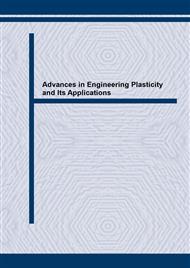[1]
B. Kriszt, P. Cekan and K. Faure, Cellular Metals and Metal Foaming Technology (MIT, Bremen 2001), P. 77.
Google Scholar
[2]
Th. Wuebben, S. Odenbach and J. Banhart, Metals and Metal Foaming Technology (MIT, Bremen 2001), P. 83.
Google Scholar
[3]
F. Siman ∨ c ík, K. Behulová and L. Borš, Metals and Metal Foaming Technology (MIT, Bremen 2001), P. 89.
Google Scholar
[4]
T. Daxner, F.G. Rammerstorfer and H.J. Böhm, Materials Science and Technology Vol. 16(2000), P. 935.
Google Scholar
[5]
K. Shinagawa, T. Kaneko, M. Nakashima and Y. Hirashima: Key Engineering Materials Vols. 177-180(2000), P. 23.
Google Scholar
[6]
K. Shinagawa: Simlulation of Materials Processing: Theory, Mehods and Applications (Balkema, Lisse 2001), P. 1053. ρ ρ Fig. 5 Shape of fired body at t=120 for single-layer specimen of X=30, W=2 with relative density distribution obtained by FEM (1/2 model). Fig. 6 Shape of fired body at t=120 for laminate specimen of X=30, WU=2/WL=0, with relative density distribution obtained by FEM (1/2 model).
Google Scholar


